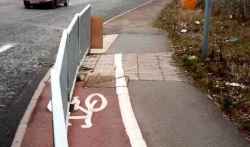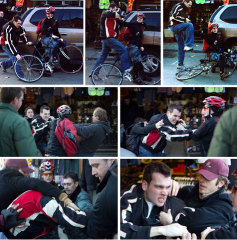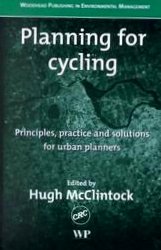
This past weekend, I rode my bike down through Surrey, North Delta and Annacis Island. It was the first time I’d taken my bike across the Alex Fraser bridge, and it had a few scary moments: a narrow sidewalk, and a low railing, plus three danger spots. The freeway signposts block the path at two points, narrowing it to essentially the width of my handlebars. At another point (shown in the photo from behind and front), the path makes a sudden sharp jog. Two of those three danger zones were in downhill sections, where cyclists could easily be riding quite fast. When I see scary bridges like this or the Second Narrows bridge, I always think about what would happen if I made a mistake. Could I tumble over the railing and fall right off the bridge? Optimistically, I assumed the engineers considered these things when they design the bridges.
Apparently not. In the paper yesterday, I saw a report from Mississauga. “From witness reports it is believed the handlebars of Sacawa’s bike may have become caught between two of the bridge’s metal posts. The impact caused him to lurch forward and tumble over the side of the bridge.” (CTV) “The railing he went over stands a bit more than one metre high, roughly the height of a tall man’s waist.” (Globe and Mail). He fell 150 feet to his death. Scary, scary stuff.
Category Archives: Transportation
Bad bicycle routes

The BBC is running an entertaining photo series on bad bicycle routes, and they have a link to some other photos too.
Apparently, they’re considering amending their highway act to require cyclists to use a bike lane if present. This is an effort by cyclists there to stop that, since so many bike lanes are badly designed or unusable. The problems are wide-ranging: obstacles in the path, too narrow, parking allowed on the bike lane, no lane sweeping, and so on.
Does it matter, when you can just break the law? Well, yes. If a driver hits a cyclist when the cyclist is breaking the law (no matter how stupid the law), the cyclist will often have a hard time getting compensation. In some European countries, the law sides with cyclists, and the responsibility almost always falls on the driver, but not in most Anglo-Saxon countries.
Toronto Transit Map

Last August, I put together a transit map for Vancouver using the new Google Maps API. I recently went through and updated all the code, switching it over to XML for the geographic data. Using that backend, I’ve now put together a Toronto transit map. So far, I’ve only got the TTC on there – GO bus and train routes would also be valuable, of course.
It was an interesting exercise to put together. I now understand why I never use the northern part of the Spadina line: north of St. Clair West, it runs directly under the Allen Expressway, which kills the life around those stations. When transit and freeways compete, freeways usually win. I also now see the folly of the Sheppard line: I think it’s too close to the 401 to compete. Additionally, since it’s north of the 401, it’ll never be able to capture much ridership from anyone living south of the 16-lane freeway, even though there’s probably more potential for dense development on the south side, closer to downtown. It’s interesting to compare the station density in Toronto and Vancouver: the Toronto stops are much, much closer together than the Vancouver stops. The new Sheppard line is similar to Vancouver station spacing, though.
And incidentally, I’ve also updated the Vancouver transit map to include the two routes that’ll be finished in 2010: the Canada Line (a.k.a. RAV / Richmond-Airport-Vancouver) that will replace the 98 B-Line and the Evergreen Line that will replace the 97 B-Line.
I’d like to allow others to add a transit layer to maps on their web pages. When I last used Housing Maps to view CraigsList listings on google maps, I found myself desperately wanting a transit overlay. I think it’d be possible to write a Mozilla addon button that just added a transit map to whatever webpage you’re viewing… I’ve just got to figure out how to do it.
Road rage

Spacing Wire is carrying a curious story about a road rage incident in Kensington Market, between a parked motorist and a bike courier. Normally, this would be no big deal, just another day in the big city. But Adam Krawesky captured some evocative photographs, and now the story is making the rounds on the Internet.
The photographs only show one side of the story, the end of the altercation. It began with passive aggression: the motorist throws food out of the window, and the courier throws the food back in the window. (Passive aggression is both very Canadian, and very typical for a cyclist, I think.) The driver then escalates to assault by dumping coffee on the courier, who retaliates with property damage by keying his car. And it ends with the driver escalating to full physical assault, shown in the photos.
The full set of images are available here.
Planning for Cycling

For some time, I’ve been curious to learn more about European approaches to designing bicycle routes. I’d heard the statistics: over 30% of all trips are made on bicycle in Amsterdam and Copenhagen, and even more in some Asian cities like Shanghai. But how did they make bike routes that were safe enough for so many people to feel comfortable doing that? Unfortunately, they publish mostly in Dutch or Danish, not English. The English-language publications I’ve seen have been dominated by American designs, which tend to be either a) stone age; or b) trying to reach the bronze age. (That’s just the state of transportation issues in the U.S., I’m afraid…)
So I was pleased to find Planning for Cycling by Hugh McClintock of the University of Nottingham. It’s a collection of chapters from a UK perspective, including chapters from several European jurisdictions. A few interesting bits of trivia from the book:
- In Denmark, all taxis must be able to carry bicycles
- The Dutch really hate bicycle helmets. While they may help with cyclists who fall off their bikes, they don’t help much in car collisions, and they’re really uncomfortable and unfashionable.
- 42% of the streets in Copenhagen have “cycle tracks” (sidewalk-level bicycle paths).
- 30% of the traffic signals in Copenhagen give cyclists priority over motor vehicles (an early green)
- Both the Danish and the Dutch acknowledge the typical factors for their success (flat terrain, “cultural” tendencies, dense cities), but also emphasize that their explicit policies supporting bicycles have been decisive influences.
- Bike-ride-bike (”sandwich”) travel is common in both Denmark and the Netherlands, where the traveller combines a transit/train ride with a bike stored at either end.
- A survey of several thousand children in the UK found that many would vastly prefer to be able to travel by bike. Over 50% of 11 year olds preferred bicycles (compared to 16% who preferred cars). I think that children really lose a lot in terms of independence and self-reliance when forced to live in car-dependent areas.
- Despite increasing federal funding by a factor of 10 between 1990 and 2000, the U.S. has only seen a 10% increase in cycling.
I’ve got quite a few notes on the book, available here.
New bike

I’ve had used bikes all my life. I did own a nice one, once upon a time – in 2000, I bought a Miele racing bike for $500 used. Unfortunately, it was stolen in 2003 just before I graduated (from behind my back, as I was picking up glass off the bike lane). At that time, I had no cash left in the bank account, so I bought an old racer from a labmate for $100 – and I mean old; it had a serial number stamped with 78xxxxxx on the bottom, and I think that means the frame’s as old as I am.
But now I have a little more cash, and I still bike everywhere. So I thought I’d invest in my first brand new bike. As a utility cycling advocate, I wanted to see if I could buy a bike off-the-shelf with all the practical things you need for commuting: fenders, a rack, a chainguard, a kickstand, and lights. I discovered that you could buy these bikes easily in Europe, but they were hard to find in North America. The Cannondale Street is a bit overpriced at $1100. Local boutique Jorg & Olif sell stylish imported Dutch bikes for $1150, but they’re not quite good enough on the hills for my house (at the top of the city’s ridge), and they’re also pretty pricey for a basic bike. There are a few other nice bikes elsewhere in North America: Kronan sells in Victoria, Breezer is at a Vancouver shop that I didn’t get to visit, Biria doesn’t have a Canadian dealer any more, and Kettler and Skeppshult never sold to Canada. So, I gave up on an off-the-shelf utility bike. It just can’t be done in North America yet. (No one even sells or displays bikes with fenders. Maybe they haven’t noticed that it rains in Vancouver yet.)
My next choice was a regular hybrid bike, with accessories tacked on. I settled on two models: the Specialized Sirrus Sport and the De Vinci Oslo. Unfortunately, I couldn’t find the gorgeous De Vinci bike in stock in my size. The De Vinci Amsterdam was even more beautiful, but a bit too flashy for my taste – too likely to get stolen. So, I went with the Specialized bike, and I haven’t regretted it one bit. The regular model had a nicer red colour, but I wanted the higher-quality components of the Sport model. I tricked it out with a full set of accessories, and finished up with a bill for about $900. There are a bunch of photos here.
I bought the bike at Dunbar Cycles in the end. I visited a lot of shops, and I was quite impressed by manager Lea Holz’s friendliness and knowledge regarding commuter bikes. I would also recommend Dizzy Cycles highly, and both Reckless Cycles and the Cyclepath were good. I’ve heard good things about the Bike Doctor but didn’t get out there. The Jorg & Olif boutique was very different but neat – lots of fashion, very few bikes – but they were fun bikes to ride.
I wasn’t very happy with Bicycle Sports Pacific’s service, which tended to be a bit pushy and know-it-all, and disparaging of commuters’ needs. and I hated Cambie Cycles weirdly sexist website enough that I didn’t even go there. Most other local bike stores had too little variety in hybrids, with more of a focus on mountain bikes or road bikes.
Secret Toronto subway stations
As a longtime Toronto subway user, I always liked the weird parts of the subway: the urban legends about running the tracks between stations, the “garbage pickup” trains around 2:00am, and the horrible stories about suicides and subsequent therapy for drivers. But I never heard about the secret stations beneath my feet. Apparently, Bay Station has a second level that was only open for six months, and Queen Station also has a second level underneath it. They’re still there, ghostly rooms in the heart of the city: Toronto’s lost subway stations.
Bike & compute
I’ve been looking around for a new set of panniers to replace my current beat-up pair. (For the uninitiated, panniers or “saddlebags” are bags that strap to the rack on the back of a bike.) Since I bike everywhere, having good bags is critical – I need to move around groceries, papers, and my computer from A to B, and I need to do it during typical Vancouver drizzles and downpours. I was a backpack man for a long time, but I needed to carry more goods, and panniers were fantastic for avoiding that sweaty back.
My biggest problem has been the computer, which is too big for my current panniers, and really needs a waterproof container. I have a Targus computer backpack that keeps the rain out, but it’s heavy and sweaty on my back. Enter Ortlieb – beautiful German-designed panniers for typical commuter purposes, although at steep prices. I finally bit the bullet, though, and picked up a $170 office-bag for the computer. It’s a real marvel of design: a roll-up top like kayaking bags for some serious waterproofing; a nice shoulder strap for carrying off-bike; and not too much of that bike-geek look. They’ve got some other good bags too, including one designed for shopping and two backpack designs.
I do own a lot of bags now. I guess it’s part of being car-free – I don’t take my own 3300L storage space around with me everywhere, so I need a few 50L bags for different purposes. (That figure is for a Saturn, with 2850L passenger volume and 450L trunk volume.)
Google Transit Map
I’ve put together a Google Map of Vancouver Transit as a test of the new Google Maps API. I’m a big fan of this technology, and I really hope they keep adding to it. I think it could do for map publishing what HTML did for text publishing: democratize and simplify it. Very cool.